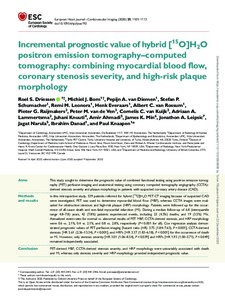Incremental prognostic value of hybrid [15O]H2O positron emission tomography-computed tomography: combining myocardial blood flow, coronary stenosis severity, and high-risk plaque morphology
Roel S Driessen; Michiel J Bom; Pepijn A van Diemen; Stefan P Schumacher; Remi M Leonora; Henk Everaars; Albert C van Rossum; Pieter G Raijmakers; Peter M van de Ven; Cornelis C van Kuijk; Adriaan A Lammertsma; Juhani Knuuti; Amir Ahmadi; James K Min; Jonathon A Leipsic; Jagat Narula; Ibrahim Danad; Paul Knaapen
Incremental prognostic value of hybrid [15O]H2O positron emission tomography-computed tomography: combining myocardial blood flow, coronary stenosis severity, and high-risk plaque morphology
Roel S Driessen
Michiel J Bom
Pepijn A van Diemen
Stefan P Schumacher
Remi M Leonora
Henk Everaars
Albert C van Rossum
Pieter G Raijmakers
Peter M van de Ven
Cornelis C van Kuijk
Adriaan A Lammertsma
Juhani Knuuti
Amir Ahmadi
James K Min
Jonathon A Leipsic
Jagat Narula
Ibrahim Danad
Paul Knaapen
Oxford University Press
Julkaisun pysyvä osoite on:
https://urn.fi/URN:NBN:fi-fe2021042824009
https://urn.fi/URN:NBN:fi-fe2021042824009
Tiivistelmä
Aims
This study sought to determine the prognostic value of combined functional testing using positron emission tomography (PET) perfusion imaging and anatomical testing using coronary computed tomography angiography (CCTA)-derived stenosis severity and plaque morphology in patients with suspected coronary artery disease (CAD).
Methods and results
In this retrospective study, 539 patients referred for hybrid [15O]H2O PET-CT imaging because of suspected CAD were investigated. PET was used to determine myocardial blood flow (MBF), whereas CCTA images were evaluated for obstructive stenoses and high-risk plaque (HRP) morphology. Patients were followed up for the occurrence of all-cause death and non-fatal myocardial infarction (MI). During a median follow-up of 6.8 (interquartile range 4.8–7.8) years, 42 (7.8%) patients experienced events, including 23 (4.3%) deaths, and 19 (3.5%) MIs. Annualized event rates for normal vs. abnormal results of PET MBF, CCTA-derived stenosis, and HRP morphology were 0.6 vs. 2.1%, 0.4 vs. 2.1%, and 0.8 vs. 2.8%, respectively (P < 0.001 for all). Cox regression analysis demonstrated prognostic values of PET perfusion imaging [hazard ratio (HR) 3.75 (1.84–7.63), P < 0.001], CCTA-derived stenosis [HR 5.61 (2.36–13.34), P < 0.001], and HRPs [HR 3.37 (1.83–6.18), P < 0.001] for the occurrence of death or MI. However, only stenosis severity [HR 3.01 (1.06–8.54), P = 0.039] and HRPs [HR 1.93 (1.00–3.71), P = 0.049] remained independently associated.
Conclusion
PET-derived MBF, CCTA-derived stenosis severity, and HRP morphology were univariably associated with death and MI, whereas only stenosis severity and HRP morphology provided independent prognostic value.
Kokoelmat
- Rinnakkaistallenteet [27094]
